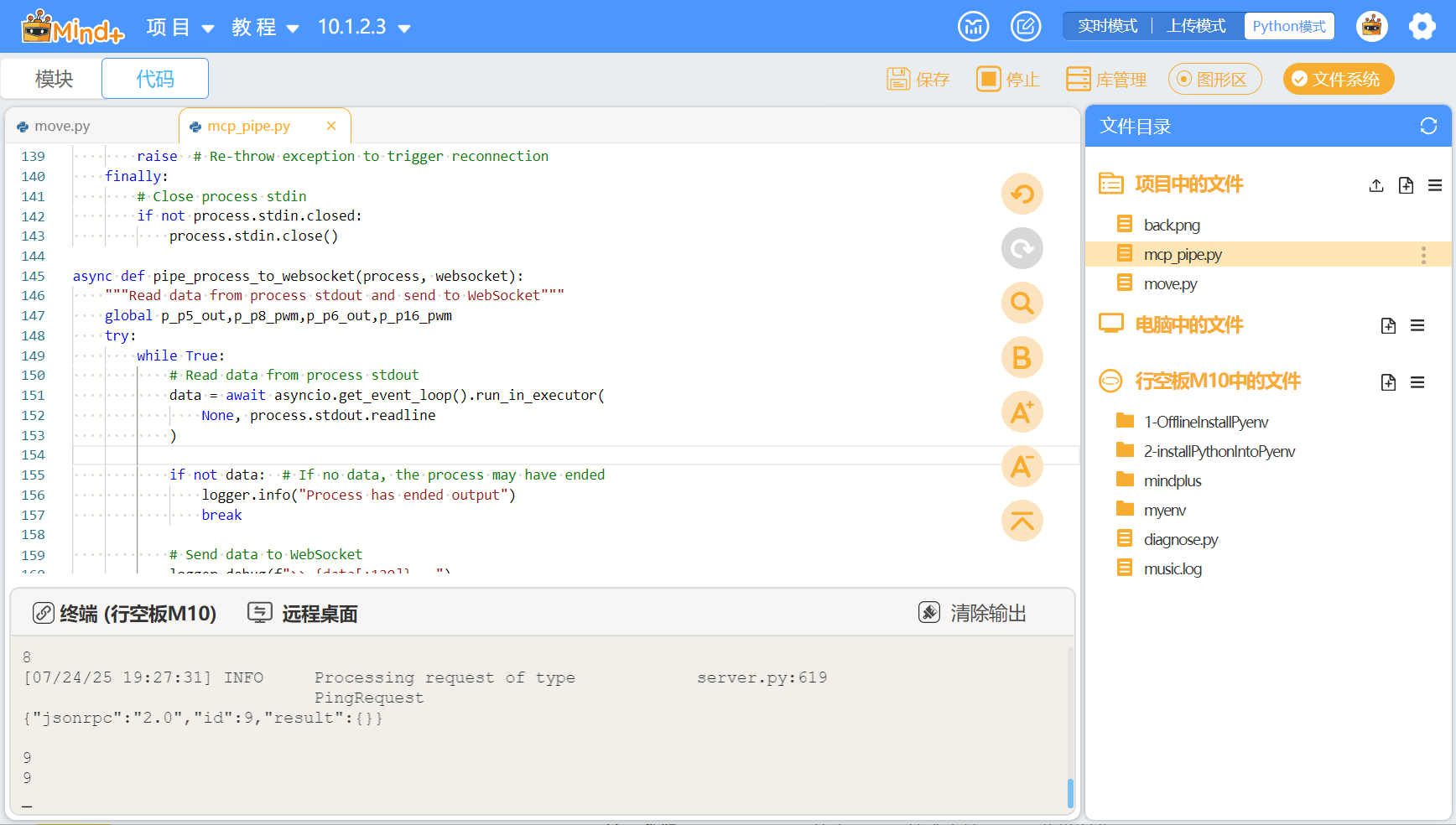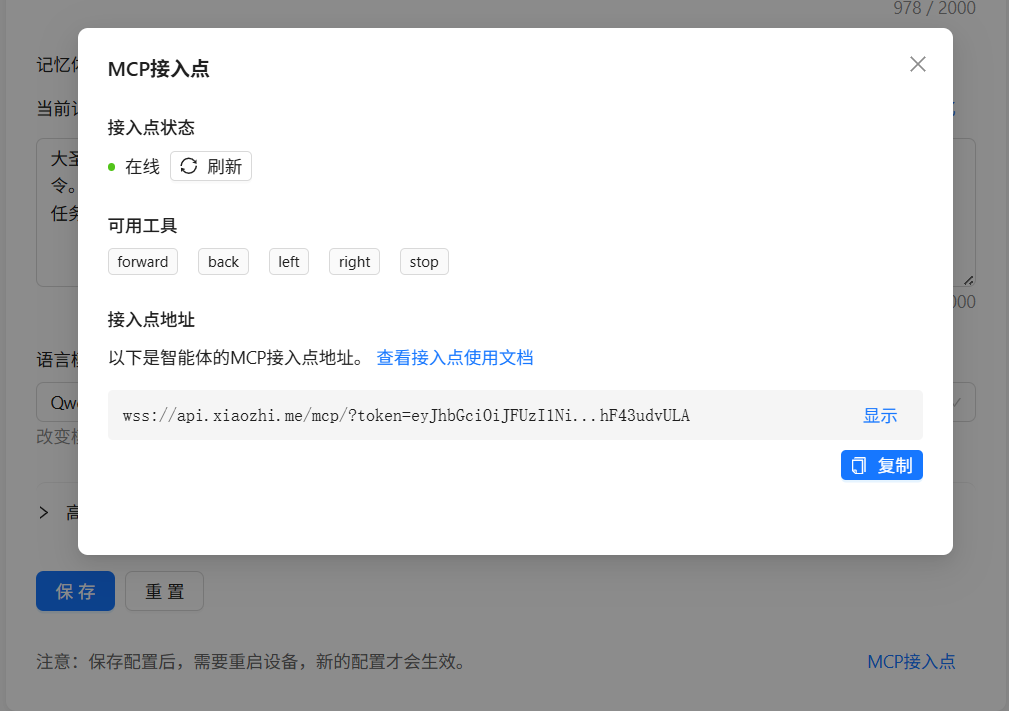7.24
【写在前面】
多足怪,也是我帖子中的常客了,很多设备都和它碰撞出过火花,M10和电池扩展板组合之后,支持MCP库了,多足怪也又双叒要上场了。
它只有两个电机,代码改起来也非常快,一次就成了。

材料清单
- M10+电池扩展板组合 X1
- 多足怪模型 X1
- 乐动小智 X1
步骤1 行空板M10上安装pyenv环境和Python 3.12.7及MCP库安装
步骤2 小智聊天机器人配置及获取MCP接入点地址
步骤3 编写M10程序
包含两个核心模块:通信管道模块(mcp_pipe.py) 和 动作服务模块(move.py)。
贴上来的是改写的代码,它们可以控制多足怪前进,后退,左转,右转,停止。
代码
# move.py
from mcp.server.fastmcp import FastMCP
import sys
import logging
logger = logging.getLogger('MoveServer')
# 修复Windows控制台UTF-8编码问题
if sys.platform == 'win32':
sys.stderr.reconfigure(encoding='utf-8')
sys.stdout.reconfigure(encoding='utf-8')
# 创建MCP服务器
mcp = FastMCP("MoveServer")
@mcp.tool()
def forward() -> dict:
"""
控制多足怪前进。
该函数将设置P5和P6引脚为低电平,P8和P16引脚为100%占空比的PWM输出,使多足怪前进。
Returns:
dict: 返回一个字典,包含操作结果。
"""
result = "多足怪前进"
logger.info(result)
return {"success": True, "result": result}
@mcp.tool()
def back() -> dict:
"""
控制多足怪后退。
该函数将设置P5和P6引脚为高电平,P8和P16引脚为100%占空比的PWM输出,使多足怪后退。
Returns:
dict: 返回一个字典,包含操作结果。
"""
result = "多足怪后退"
logger.info(result)
return {"success": True, "result": result}
@mcp.tool()
def left() -> dict:
"""
控制多足怪左转。
该函数将设置P5引脚为高电平和P6引脚为低电平,P8和P16引脚为100%占空比的PWM输出,使多足怪左转。
Returns:
dict: 返回一个字典,包含操作结果。
"""
result = "多足怪左转"
logger.info(result)
return {"success": True, "result": result}
@mcp.tool()
def right() -> dict:
"""
控制多足怪右转。
该函数将设置P5引脚为低电平和P6引脚为高电平,P8和P16引脚为100%占空比的PWM输出,使多足怪右转。
Returns:
dict: 返回一个字典,包含操作结果。
"""
result = "多足怪右转"
logger.info(result)
return {"success": True, "result": result}
@mcp.tool()
def stop() -> dict:
"""
控制多足怪停止。
该函数将设置P8和P16引脚的PWM输出为0,使多足怪停止。
Returns:
dict: 返回一个字典,包含操作结果。
"""
result = "多足怪停止"
logger.info(result)
return {"success": True, "result": result}
# 启动服务器
if __name__ == "__main__":
mcp.run(transport="stdio")
代码
"""
This script is used to connect to the MCP server and pipe the input and output to the websocket endpoint.
Version: 0.1.0
Usage:
export MCP_ENDPOINT=
python mcp_pipe.py
"""
# -*- coding: UTF-8 -*-
# MindPlus
# Python
from unihiker import GUI
import asyncio
import websockets
import subprocess
import logging
import os
import signal
import sys
import random
from dotenv import load_dotenv
from pinpong.board import Pin
from pinpong.board import Board
from pinpong.board import Board,Pin
#from pinpong.extension.unihiker import *
import json
Board().begin()
u_gui=GUI()
p_p5_out=Pin(Pin.P5, Pin.OUT)
p_p8_pwm=Pin(Pin.P8, Pin.PWM)
p_p6_out=Pin(Pin.P6, Pin.OUT)
p_p16_pwm=Pin(Pin.P16, Pin.PWM)
u_gui.draw_image(image="back.png",x=0,y=0)
u_gui.draw_text(text="M10怪兽MCP",x=30,y=10,font_size=25, color="#FFFFFF")
# 设置日志记录器
# Load environment variables from .env file
#load_dotenv()
# Configure logging
logging.basicConfig(
level=logging.INFO,
format='%(asctime)s - %(name)s - %(levelname)s - %(message)s'
)
logger = logging.getLogger('MCP_PIPE')
# Reconnection settings
INITIAL_BACKOFF = 1 # Initial wait time in seconds
MAX_BACKOFF = 600 # Maximum wait time in seconds
reconnect_attempt = 0
backoff = INITIAL_BACKOFF
async def connect_with_retry(uri):
"""Connect to WebSocket server with retry mechanism"""
global reconnect_attempt, backoff
while True: # Infinite reconnection
try:
if reconnect_attempt > 0:
wait_time = backoff * (1 + random.random() * 0.1) # Add some random jitter
logger.info(f"Waiting {wait_time:.2f} seconds before reconnection attempt {reconnect_attempt}...")
await asyncio.sleep(wait_time)
# Attempt to connect
await connect_to_server(uri)
except Exception as e:
reconnect_attempt += 1
logger.warning(f"Connection closed (attempt: {reconnect_attempt}): {e}")
# Calculate wait time for next reconnection (exponential backoff)
backoff = min(backoff * 2, MAX_BACKOFF)
async def connect_to_server(uri):
"""Connect to WebSocket server and establish bidirectional communication with `mcp_script`"""
global reconnect_attempt, backoff
try:
logger.info(f"Connecting to WebSocket server...")
async with websockets.connect(uri) as websocket:
logger.info(f"Successfully connected to WebSocket server")
# Reset reconnection counter if connection closes normally
reconnect_attempt = 0
backoff = INITIAL_BACKOFF
# Start mcp_script process
process = subprocess.Popen(
['python', mcp_script],
stdin=subprocess.PIPE,
stdout=subprocess.PIPE,
stderr=subprocess.PIPE,
encoding='utf-8',
text=True # Use text mode
)
logger.info(f"Started {mcp_script} process")
# Create two tasks: read from WebSocket and write to process, read from process and write to WebSocket
await asyncio.gather(
pipe_websocket_to_process(websocket, process),
pipe_process_to_websocket(process, websocket),
pipe_process_stderr_to_terminal(process)
)
except websockets.exceptions.ConnectionClosed as e:
logger.error(f"WebSocket connection closed: {e}")
raise # Re-throw exception to trigger reconnection
except Exception as e:
logger.error(f"Connection error: {e}")
raise # Re-throw exception
finally:
# Ensure the child process is properly terminated
if 'process' in locals():
logger.info(f"Terminating {mcp_script} process")
try:
process.terminate()
process.wait(timeout=5)
except subprocess.TimeoutExpired:
process.kill()
logger.info(f"{mcp_script} process terminated")
async def pipe_websocket_to_process(websocket, process):
"""Read data from WebSocket and write to process stdin"""
try:
while True:
# Read message from WebSocket
message = await websocket.recv()
logger.debug(f"<< {message[:120]}...")
# Write to process stdin (in text mode)
if isinstance(message, bytes):
message = message.decode('utf-8')
process.stdin.write(message + '\n')
process.stdin.flush()
except Exception as e:
logger.error(f"Error in WebSocket to process pipe: {e}")
raise # Re-throw exception to trigger reconnection
finally:
# Close process stdin
if not process.stdin.closed:
process.stdin.close()
async def pipe_process_to_websocket(process, websocket):
"""Read data from process stdout and send to WebSocket"""
global p_p5_out,p_p8_pwm,p_p6_out,p_p16_pwm
try:
while True:
# Read data from process stdout
data = await asyncio.get_event_loop().run_in_executor(
None, process.stdout.readline
)
if not data: # If no data, the process may have ended
logger.info("Process has ended output")
break
# Send data to WebSocket
logger.debug(f">> {data[:120]}...")
print(data)
# 解析 JSON 字符串
json_str = json.loads(data)
print(json_str['id'])
if json_str['id']>1:
print(json_str['id'])
if json_str.get('result', {}):
text=json.loads(json_str['result']['content'][0]['text'])
if text['success']:
print(text['result'])
L=480
if "前进" in text['result']:
print("******************************")
p_p5_out.write_digital(0)
p_p8_pwm.write_analog(1023)
p_p6_out.write_digital(0)
p_p16_pwm.write_analog(1023)
if "后退" in text['result']:
print("******************************")
p_p5_out.write_digital(1)
p_p8_pwm.write_analog(1023)
p_p6_out.write_digital(1)
p_p16_pwm.write_analog(1023)
if "左转" in text['result']:
print("******************************")
p_p5_out.write_digital(1)
p_p8_pwm.write_analog(1023)
p_p6_out.write_digital(0)
p_p16_pwm.write_analog(1023)
if "右转" in text['result']:
print("******************************")
p_p5_out.write_digital(0)
p_p8_pwm.write_analog(1023)
p_p6_out.write_digital(1)
p_p16_pwm.write_analog(1023)
if "停止" in text['result']:
print("******************************")
p_p8_pwm.write_analog(0)
p_p16_pwm.write_analog(0)
# In text mode, data is already a string, no need to decode
await websocket.send(data)
except Exception as e:
logger.error(f"Error in process to WebSocket pipe: {e}")
raise # Re-throw exception to trigger reconnection
async def pipe_process_stderr_to_terminal(process):
"""Read data from process stderr and print to terminal"""
try:
while True:
# Read data from process stderr
data = await asyncio.get_event_loop().run_in_executor(
None, process.stderr.readline
)
if not data: # If no data, the process may have ended
logger.info("Process has ended stderr output")
break
# Print stderr data to terminal (in text mode, data is already a string)
sys.stderr.write(data)
sys.stderr.flush()
except Exception as e:
logger.error(f"Error in process stderr pipe: {e}")
raise # Re-throw exception to trigger reconnection
def signal_handler(sig, frame):
"""Handle interrupt signals"""
logger.info("Received interrupt signal, shutting down...")
sys.exit(0)
if __name__ == "__main__":
# Register signal handler
signal.signal(signal.SIGINT, signal_handler)
# mcp_script
#if len(sys.argv) < 2:
# logger.error("Usage: mcp_pipe.py ")
# sys.exit(1)
mcp_script = "move.py"
# Get token from environment variable or command line arguments
#endpoint_url = os.environ.get('MCP_ENDPOINT')
endpoint_url="wss://api.xiaozhi.me/mcp/?token=*********"
if not endpoint_url:
logger.error("Please set the `MCP_ENDPOINT` environment variable")
sys.exit(1)
# Start main loop
try:
asyncio.run(connect_with_retry(endpoint_url))
except KeyboardInterrupt:
logger.info("Program interrupted by user")
except Exception as e:
logger.error(f"Program execution error: {e}")在Mind+中运行mcp_pipe.py。

当终端如上图,小智MCP服务连接成功。
此时,小智控制台接入点状态:在线,可用工具:可见。

用小智AI和怪兽互动。

 返回首页
返回首页
 回到顶部
回到顶部


评论